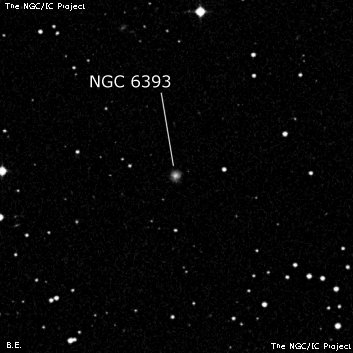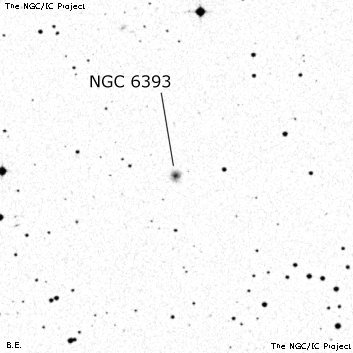NGC/IC Project Restoration Effort
(This is a very very beta version)
NGC6393


Basic Information
Location and Magnitude
Right Ascension: 17:30:8.5
Declination: +59:31:55
Constellation: DRA
Visual Magnitude: 15.7
Historic Information
Discoverer: Swift L.
Year of discovery: 1885
Discovery aperture: 16.0
Observational
Summary description: eF, pS, R, s of 2
Sub-type: S?
Corwin's Notes
=====
NGC 6393 and NGC 6394 are a pair of objects found 7 July 1885 by Lewis Swift.
Though he describes the two as equally faint, the southern of the two objects
on the sky (more than 6 arcmin south of his position) is much fainter than the
northern (3.5 arcmin south of the nominal position). I'm not convinced that
Swift could have seen it.
In fact, he did not find it again. When he went over the field on 15 June
1890, he recovered only one of the galaxies. This time, his position was
virtually identical to the one that he gave for N6393, leading Dreyer to omit
it from IC1. The position is also close to the true position for the brighter
galaxy. Swift's description also fits the brighter galaxy: "eeF, pS, cE; B *
nearly obscures it; bet. it and a F *[,] nearer the latter." So, there is no
doubt about the galaxy that this second observation points to.
This brighter galaxy has been taken by MCG and CGCG as N6393 based on the
position. However, Swift's description does not match the field. Swift says,
"vvF, pS, R; 2 B sts nr n; s of 2." The comment about the two bright stars
north matches the fainter southern galaxy, but not the brighter northern one.
For his northern object, Swift says, "vvF, pS, R; 2 sts point to it, the
nearer is D; the other and the neb. are equally distant from the D *; n of 2."
This matches what is on the sky pretty well (his double star in the first
observation is the "B *" in the second, and the other two stars are there
also), so I have taken NGC 6394 as the northern galaxy. I have also
tentatively assigned NGC 6393 to the very faint southern object since there is
no other candidate object nearby. There are many other galaxies within one or
two degrees, but none have the stars near that Swift describes. Whatever he
saw, it clearly needs visual confirmation.
After reading the note above, Steve Gottlieb took a look at these two galaxies
during one of his observing runs in the California Sierras with his 18-inch
reflector in July 2008. Here are his notes:
You identified the brighter northern galaxy as N6394. I felt this galaxy
was brighter than Swift's 1890 description of "eeF" but he correctly logged
it as "cE". Here are my notes at 280x: "Faint, fairly small, very
elongated 3:1 SSW-NNE, 0.6'x0.2', very weak concentration. An extremely
faint star is off the NNE tip. Located 4' SE of mag 8.0 HD 159266 which
detracts from viewing."
As far as the much fainter southern galaxy (N6393), I was able to pick it up
but it wasn't easy and my notes are pretty basic: "Extremely faint, very
small, round, 15" diameter, low even surface brightness."
With some effort I could just barely hold this galaxy continuously with
averted vision at 280x once it was identified BUT it took knowing the exact
position to initially pick it up. ...
Based on the eyepiece view, I'd say the southern galaxy is faint enough that
I doubt Swift would have noticed it without prior knowledge. But although
it seems unlikely to me, it's just possible Swift picked it up in the field
of the brighter northern galaxy. ...
While this seems to confirm my initial thoughts about the field, I can only
echo Steve's conclusion:
So, I'm afraid we may still be left with an uncertain (or unlikely)
identification for N6393 without some other info.
I've put colons on NGC 6394 in my main position tables. The question mark on
NGC 6393 remains firmly in place.
Coming on these two objects again in January 2016, I realized that I had not
considered the other galaxies that Swift found on the same night. They are
Swift Modern Mod - Sw
NGC RA (2000) Dec RA (2000) Dec dRA dDec
s amin
6381 17 27 15 +60 00.4 17 27 16.83 +60 00 50.3 + 1.8 +0.5
6390 17 28 17 +60 11.7 17 28 28.08 +60 05 39.2 +11.1 -6.0
6399 17 31 43 +59 36.4 17 31 50.31 +59 36 55.7 + 7.3 +0.5
Swift's RA's are systematically low, and he has one declination that is six
arcminutes too large. Assuming that he found the objects in RA order, we can
apply the corrections implied by the NGC 6390 differences to Swift's positions
for NGC 6393 and 6394. This gives for J2000
NGC 6393: 17 30 29 +59 32.4
NGC 6394: 17 30 28 +59 36.0
These implied positions suggest that the identifications that Steve and I had
suggested earlier are in fact correct. But given Steve's uncertainty about
Swift's chances of sweeping up the fainter galaxy, I've again left the
uncertainty symbols intact.
Steve's Notes
=====
NGC 6393
18" (7/30/08): extremely faint, very small, round, 15" diameter, low even surface brightness. I could just barely hold this galaxy continuously with averted vision once it was identified but it took knowing the exact position to initially pick up. This galaxy is generally identified as NGC 6394. Although Swift's description for NGC 6393 is a better match with this galaxy it's possible that it is too faint for Swift to have picked up.
17.5" (6/18/88): not found



